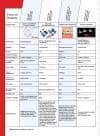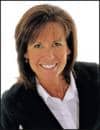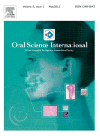by Alan Ruskin
How a former cricketer became an award-winning orthodontics professor
 |
Caps, 19; Runs, 431; ODI century as part of an opening stand of 225; Top score, 122.
The game of cricket may not be familiar to most Americans, despite its being the ancestral English version of our venerable game of baseball. But it is very familiar to a certain orthodontist who teaches at Jacksonville University in Florida. And not only is Dipak Chudasama, BDS, MSC, MORTH RCS, acquainted with the game, but as a former world-class cricketer he is actually the holder of the statistical records mentioned above. Chudasama represented Kenya in many international tournaments, including the 1999 World Cup held in the UK, during which he played the distinguished role of “opening batsman.” He retired from competition that same year.
And what, you may wonder, do his cricket exploits, or the fact that he also represented Kenya in table tennis, have to do with his current position as assistant professor of orthodontics and director of research at Jacksonville University? “My diverse background,” Chudasama says, “including sports, the different places I’ve been and lived in, and my varied educational background, has allowed me to incorporate different styles in my approach to teaching, bringing out the best in my research and clinical skills.”
Commenting on the beneficial effects of his athletic career, Chudasama adds, “Cricket taught me always to be a team player. Once you’re done with the profession [of orthodontics], life then becomes more about how many of your colleagues still want to know you. Hence, one must learn to earn the respect of not only your peers, but also those that work under you.”
PRACTICE PROFILE
Name: Dipak Chudasama, BDS, MSC, MORTH RCS
Location: Jacksonville, Fla
Owner: Jacksonville University
Specialty: Teaching orthodontics and researching and testing products, especially archwires
Years in teaching orthodontics: 4 (14 prior years as dentist)
Days worked per week: 4
Patients per day: 35 to 50
Starts per year: 1,000
Square footage: 13,500 feet
Chudasama’s deep commitment to teaching and research has not gone unrecognized: He was awarded the 2008 Excellence in Orthodontic Education Award by the board of directors of the Southern Association of Orthodontists. As the award stipulates, it is given “based on the performance of innovative teaching, exceptional mentoring of residents, and contributions to the specialty and research.”
“I Learned from Roth”
Born and raised in Mombasa, Kenya, Chudasama went to India to receive his dental degree from Mangalore University, in Karnataka. He then practiced general dentistry for a decade in Nairobi, Kenya, and it was there, during an international cricket match, that he encountered the late Ron Roth, DDS, MS, who convinced Chudasama to attend London’s Eastman Dental Institute, where he received his master’s degree. “Ron Roth had a great influence in my life as a mentor,” Chudasama says, “and invited me to take his 2-year finishing course in Detroit after I received my master’s degree in 1997.” He credits Roth with his eclectic approach to teaching. “I learned from Roth to take the best from various disciplines.” In 2004, Chudasama added to his education by earning diplomas of membership in orthodontics from the Royal College of Surgeons of England and the Royal College of Surgeons of Edinburgh.
 |
| Two residents look on as Chudasama turns a routine wire change into a teachable moment in the clinic at Jacksonville University. |
“My Students Should Exceed Me”
Engaged in full-time academics without a private practice, Chudasama sees patients in a university setting where he oversees his residents’ cases, and is “comfortable where I am.” The School of Orthodontics at Jacksonville is fairly new, but growing, according to Chudasama, and currently admits 14 residents plus four orthodontic fellows per year in a 2-year program. Chudasama strives to maintain a progressive approach in dealing with his students. “My philosophy is that my students should ultimately exceed me in their capabilities. Mankind has always progressed because your students become better than you. So whomever you’re teaching should one day be out there telling you how it’s actually done.”
In keeping with his farsighted views, Chudasama spends a good deal of time reading books on positive thinking and the pursuit of enlightenment, including the works of his near-namesake, Deepak Chopra. He is passionate about value creation and an “everybody wins” attitude, and believes in uniting people toward a common, positive goal. His concern for values imbues his notion of how an orthodontic practice should be conducted: “Be ethical in your treatment choices, and treat patients who have an actual treatment need where the benefit outweighs the risks.”
“Borrowing Does Not Make You Rich”
Idealistic though he may be, Chudasama definitely has his practical side, which led him to participate in an Executive MBA degree program at Jacksonville. “I have just a couple of weeks to go to get my degree. It’s an 18-month program, and it’s been a very interesting journey.” On the importance of learning the business side of the profession, he comments, “Teaching in orthodontics trains you to do the work, but no one teaches you how to do the business. The current orthodontic school curriculum in most schools does not adequately prepare residents for the business environment and hence leaves them exposed to bad choices and decisions. With the increasing amount of student debt that residents currently have, a business course is my strongest recommendation.”
In the course of the MBA program, he has taken courses that cover management, financial accounting, human resources, computers, legal issues, and ethics. “They’ve all been wonderful,” he says, and he hopes to continue to “integrate a business curriculum into the mainstream orthodontic education that residents currently receive in order to better prepare them for the real world.”
He believes that, especially in the current economic climate, it’s essential that students as well as practicing orthodontists learn how to handle their income. “You know you’re going to make money, so you need to learn how to invest it wisely. Over time, you tend to rely on ‘experts’ to get you through, but in actuality it’s often the case that they would not be the best choice unless you have a basic background in business and investment management.” He recounts the case of one orthodontist who recently told him, regretfully, “If I hadn’t invested in anything, I’d be better off.”
Chudasama says that the university offers students a program in leadership and entrepreneurship. It is admittedly modest at this juncture, but “I have been adding to it from what I’ve learned in my MBA program. We also have speakers who come in from outside who tell you what to do and what not to do. I believe in the basic principle of not borrowing what you can’t repay. Borrowing does not make you rich.”
He sums up the challenge of business management in his typically philosophical, broad-minded manner. “In life, one has to be willing to anticipate and accept paradigm shifts. You are never to the point where you can’t learn something new from an experience; you’re always looking for greater progress even if you’re already at a high level.”
 |
| Chudasama, who serves as director of research in Jacksonville University’s orthodontics department, is currently conducting clinical trials on a new aesthetic composite archwire. |
“I Have a Passion for Archwire Research”
Chudasama has a lot of respect for the teaching curriculum at the school. “Every case treated at JU (Jacksonville University) is studied by a panel of doctors and residents in a morning diagnostic and afternoon progress seminar in order to maximize both the teaching value as well as excellence in treatment for the patient.”
As much as he enjoys teaching and encouraging students, Chudasama, as director of research, is equally taken with evaluating new products. He’s currently absorbed in conducting trials on a new aesthetic composite archwire manufactured by Biomers Group. He says Jacksonville is the second school to have the opportunity to test this particular wire. “It’s a clear wire, and would be very hard to pick up in the mouth. We’re currently testing the round version, with the square and rectangular yet to come.” The round version, he adds, is the only one of its type created thus far.
“Others have introduced clear wires before,” he says, “but none have stood the test of time.” He says the new wire has been introduced to the market, but “it’s still too early to comment about it.” He does reveal that the wire material has changed over the course of its development, but the details are a trade secret at this time.
“I have a passion for archwire research, and I am always testing and playing with new archwires to see what happens in the clinical environment,” he says. The practical question that must always be answered, he says, is, “Does the wire do what it is being marketed for?” He presented the latest data on the clear wire at the recent AAO meeting in Boston.
Chudasama believes that as an academic orthodontist he has “an advantage because in the school/teaching environment I’m exposed to the latest published techniques and material. This allows me to refine my clinical skills as well as validate contemporary research materials and assess their efficacy.”
He states, “Contemporary technology has a lot of potential. Orthodontists need to understand their tools better, especially the new generation of brackets and archwires. The composite wire research is exciting. It will be interesting to see how the profession receives it. I do see these wires being used in my lifetime. The technology can only get better.”
 |
“The Institution Stays”
Chudasama has a special concern for the regulating bodies of orthodontics, such as the AAO, ABO, and the regional SAO. “I hope that one day all orthodontists will give these organizations the respect and recognition they deserve.”
Expanding on this, he continues, “Life is a little different on the American side. Overseas, there’s a system in place, and that has its pros and cons. When you have a system in place, people have something to follow. Here it’s more of an entrepreneur-type setting, where rules and regulations in the orthodontic world are not that strongly adhered to.
“But at the same time, that’s also beneficial when you’re coming up and you can think outside the box, because a mistake that we all make is we get caught in a paradigm, and we don’t try to think beyond that paradigm. So I think the system here has its pluses, but in the end, the bodies that run it, the AAO and ABO, should be given their due respect.”
Concluding this line of thought, he adds, “I came from a different school, where if I looked at the CEO of a company, it was not at the person, but the chair he sat on. My ultimate respect is for the institution. People will come and go, but the institution stays. You always want to leave your institutions better than how you found them. So the institutions of the AAO and ABO need to be respected.”
Chudasama believes his most rewarding experience as an academic orthodontist is “the positive feedback I receive from my residents and the award that I won.” He also values all of the “new friends I’ve made over the years both through residents, educators, and clinicians that I’ve had the privilege to interact with.”
His advice to new orthodontists? “Be humble, and don’t forget to give back to the profession, to your school, and to the community.”
And on a final, more clinical note, Chudasama advises that, “Just when you think you have figured out orthodontics, it will throw a curve ball at you. Learn to find a balance between evidence-based and clinical orthodontic practice.”
Alan Ruskin is a staff writer for Orthodontic Products. For more information, contact





